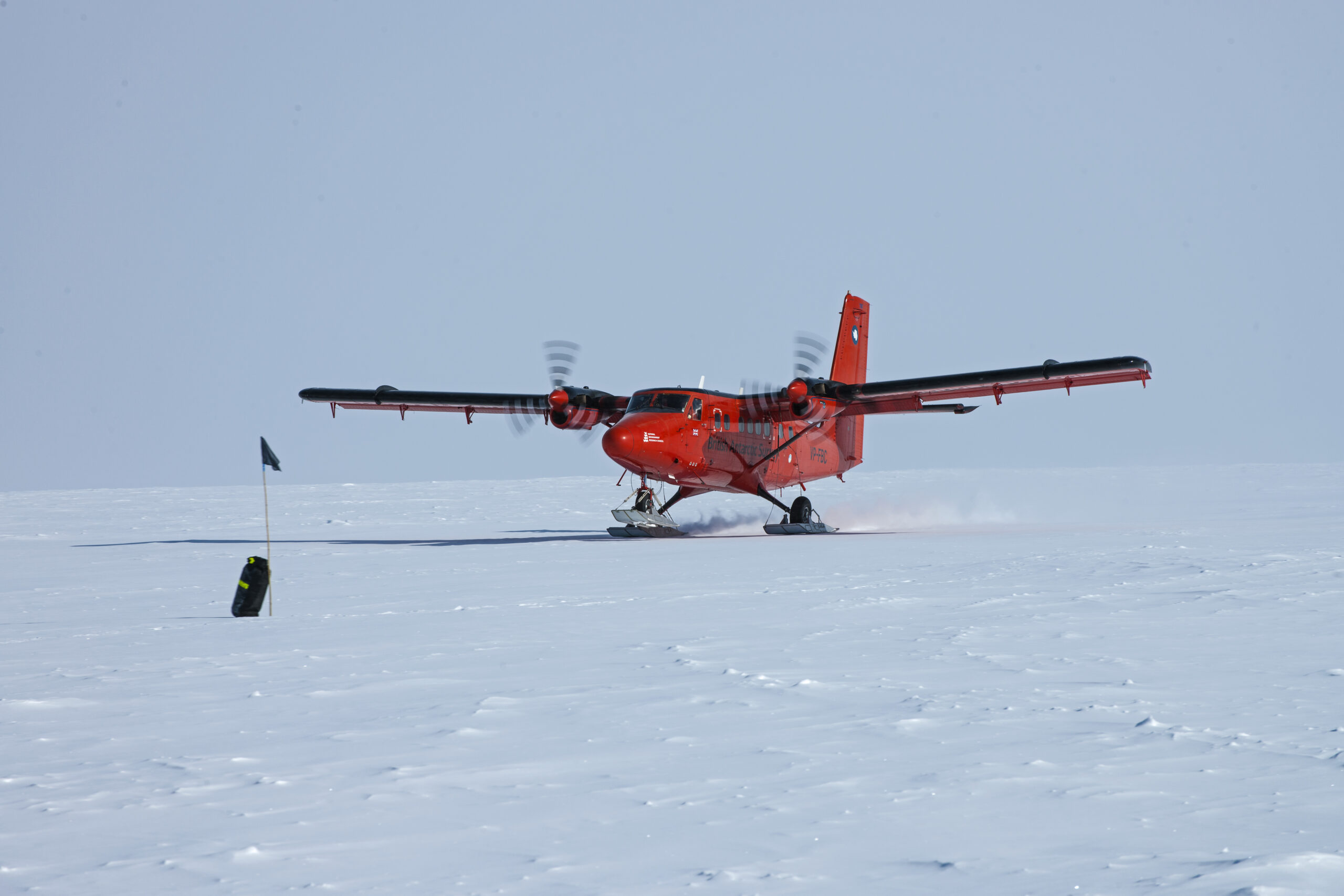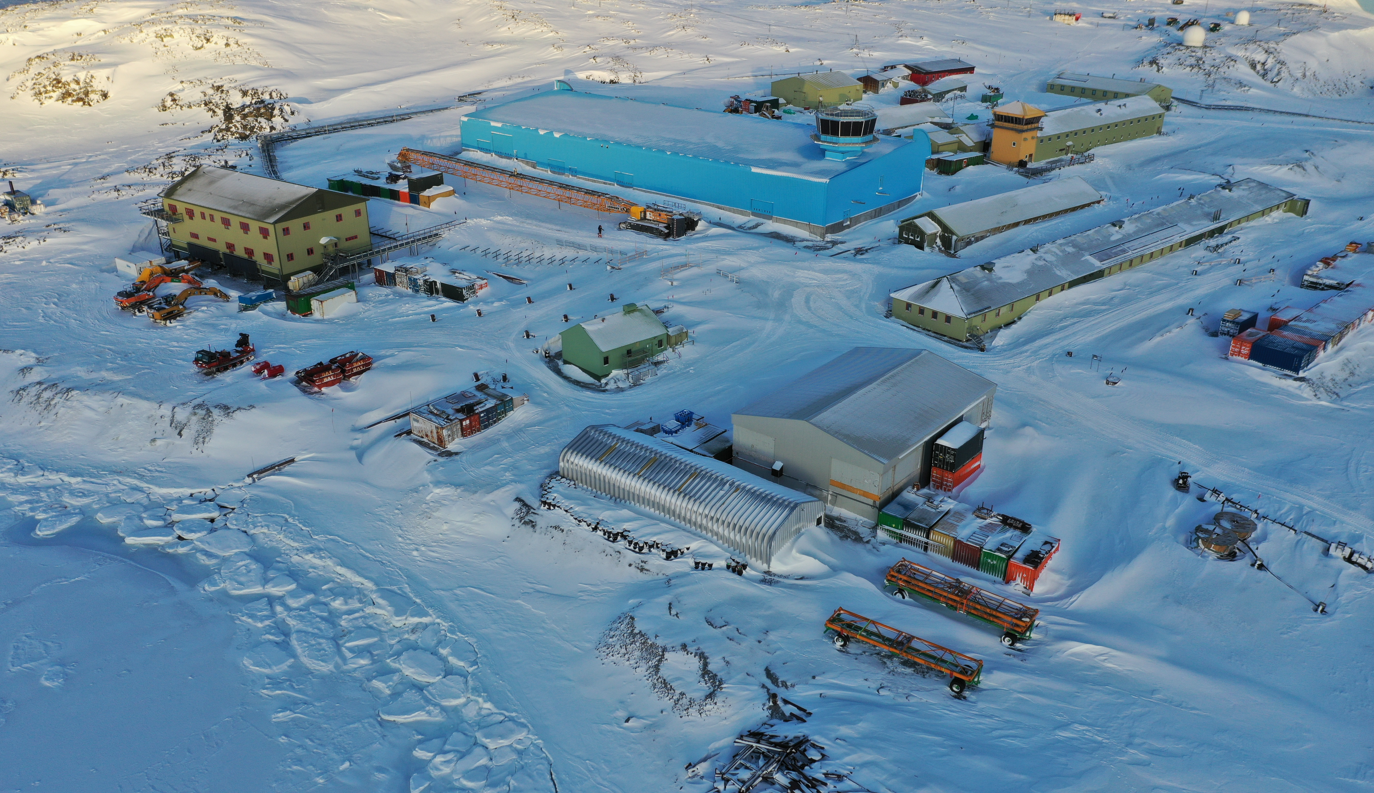The Antarctic field season is now underway, marked by the arrival of the first aircraft at Rothera Research Station. And with a new season brings a new roster of innovative and exciting projects being delivered across British Antarctic Survey's (BAS) five research stations and the UK's polar research ship, the RRS Sir David Attenborough. Over the coming months, teams will be heading South to deliver around 60 research projects across the Antarctic and sub-Antarctic.
The RRS Sir David Attenborough left the UK on 13 October to begin its five-week journey to the stations. The ship is making the 7,000 nautical mile journey to the Falkland Islands using hydrotreated vegetable oil (HVO); a biofuel which is a key part of BAS' efforts to reduce its carbon footprint.
This season, which runs from October to June, construction on the new Discovery Building at Rothera Research Station continues. This new facility is a combination of previous buildings and will futureproof BAS polar operations.
Professor Dame Jane Francis, Director of British Antarctic Survey says:
"With the 2024/25 season firmly in motion, research supporting BAS' long-term scientific strategy of Polar Science for a Sustainable Planet is underway.
"Recent news of extreme weather reinforces that research to understand our changing climate is more vital than ever. Whether through modelling, monitoring or field work, the importance of polar research has never been so critical to advance our understanding of the frozen continent and beyond."

This season's science highlights
Following the success of last year's BIOPOLE I science mission, the first major peer-reviewed science to be carried out on the RRS Sir David Attenborough, BIOPOLE II is set to take place in early 2025, continuing investigation into the crucial role polar ecosystems play in regulating global carbon and nutrient cycles. The mission will cover large areas of the Scotia and Weddell Seas, and venture into the edge of the sea ice to sample across a range of environments with different levels of biological productivity - this time in the austral autumn.
As part of the Southern Ocean Clouds project, researchers are bringing together land-, ship- and aircraft-based measurements of high-latitude mixed-phase clouds (clouds made up of both water and ice and typically found in the polar regions) to improve how they are represented in climate models. In the 2024-25 season, simultaneous measurements of these clouds will be collected from the RRS Sir David Attenborough and by a BAS Twin Otter aircraft. Further long-term measurements will also be taken from the science facility at East Beach Hut at Rothera Research Station.
The 2024-25 season also sees the second phase of the RIFT-TIP drilling project on the Brunt Ice Shelf, on which the BAS Halley Research Station is located. This project seeks to explain the factors influencing the propagation of cracks in ice shelves and rift growth. The team will be carrying out a detailed geophysical study of ice properties and fracture behaviour at the eastern end of the Halloween Crack (named as such because it was discovered on Halloween) using radar surveys, GPS, laser measurements and seismometers. They will also drill four ice cores from near the crack for further analysis.
Halley VI Research Station
Based out of the Halley VI Research Station, the close glaciological monitoring of the Brunt ice shelf continues. Following three calving events between 2021 and 2024, the Brunt ice shelf is now the most observed ice shelf on Earth. With equipment ranging from 11 GPS instruments measuring ice deformation around Halley VI, to satellite imagery from ESA, NASA and the German Aerospace Agency, scientists will use data from a network of instruments and models to understand the changing risk to operations and infrastructure in the area. Our fleet of automated science equipment continues to collect data year-round on ozone, space weather and the atmosphere.
Rothera Research Station
At Rothera Research Station, marine biological research will continue to monitor animals living in the surface waters of Ryder Bay. BAS will deploy Baited Remote Underwater Video systems (BRUVs) to gather valuable data on how annual variation in oceanography and sea ice affects species like algae as well as the krill which feed off them. Projects will look at iceberg disturbance to the seabed around Rothera, alongside the Rothera Time Series, which collects year-round oceanographic data alongside long-term data related to ozone and the atmosphere.

Deep-field science
As Rothera Research Station serves as a gateway into deep field Antarctica, it will support several collaborative projects this season such as the subglacial drilling in the Behrendt Mountains (on the Antarctic Peninsula) to investigate West Antarctic Ice Sheet collapse. Other deep field work includes maintenance of remote weather stations to preparations for deep ice core drilling close to the Sky-Blu ice runway, to an operational tractor-traverse to return two ice tractors, called PistenBullys, from a depot near Thwaites Glacier - a drive of more than 1,000km.
King Edward Point Research Station
As part of the Hungry Humpbacks project, researchers at King Edward Point Research Station will be conducting small-boat surveys and gathering UAV images of humpback whales near Cumberland Bay to improve our understand of their impact on krill populations. The 2024-25 season also sees the biennial groundfish survey at South Georgia, in partnership with the Government of South Georgia and the South Sandwich Islands, and an assessment of southern elephant seal populations using a combination of images from both satellites and Remotely Piloted Aerial Systems (RPAS).
Bird Island Research Station
Ongoing research into marine predators at Bird Island Research Station continues this season. Albatrosses, petrels, penguins and seals are all studied intensively with data informing conservation of these iconic species.
Signy Island Research Station
For the 2024/25 season, researchers at Signy Island Research Station will be focusing on how the environment is responding to climate change. Working with Italian collaborators one project will gain a better understanding of the impact climate change has on terrestrial (Earth-based) ecosystems, by analysing the permafrost and snow, vegetation and soils and hydrosphere (permafrost hydrology) for measurable changes.
Extreme operations
Work will continue this season to complete the Discovery Building. At Rothera Research Station, the Antarctic Infrastructure Modernisation Programme (AIMP) construction team will focus on finishing the internal fit out of this new scientific support and operations facility as well as testing its systems in time for handing over the building in April 2025. If you want to keep up to date with how the Discovery Building is progressing, be sure to check out the Postcards from Rothera series - you can find the first one here.
Sharing the magic of Antarctica
Providing a floating laboratory for the UK polar community to conduct research in the polar regions is not the only role the RRS Sir David Attenborough is providing this season - the ship is currently carrying an exciting addition onboard in the form of a time capsule. Made from the head of a hot water drill used for extracting ice cores, the capsule contains the names of more than 13,000 people from all around the world and forms part of BAS' Ticket to Antarctica project.
There's still time to sign up here if you haven't already, just make sure to do it soon so your name can live forever in Antarctica!

Today, BAS also launches the fourth season of the Iceworld podcast. Recorded and presented by former BAS marine biologist Nadia Frontier, Iceworld features interviews with the ordinary people who are doing extraordinary jobs in Antarctica, including polar scientists, vehicle mechanics, chefs and plumbers. The new season follows the summer science season in Antarctica - starting with a conversation with BAS pilots shortly before they began the ferry flights of the Twin Otter and Dash 7 Aircraft to Antarctica. Episode 1, Piloting flights from Canada to Antarctica, with Vicky Auld and Olly Smith, can be found on all major podcast platforms, including Spotify, Amazon Music and Apple Podcasts, as well as YouTube.






